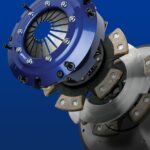The Cummins 8.3 ISC is a legendary engine in the medium-duty diesel market. Known for its durability, reliability, and power, this workhorse has powered everything from school buses and RVs to excavators and generators for over three decades. This article delves into the history, specifications, common problems, and remanufacturing process of the iconic 8.3 Isc Cummins engine.
Evolution of the 8.3 ISC: From 6CT to Common Rail
The 8.3 ISC’s story begins with its mechanically injected predecessor, the 6CT. In the late 1990s, Cummins revolutionized the platform, introducing the electronically controlled ISC with CAPS (Cummins Accumulator Pump System) fuel injection. This marked a significant leap forward in performance and emissions control. Later, the ISC transitioned to high-pressure common-rail (HPCR) injection, further enhancing efficiency and power.
Key Technological Advancements
The CAPS Era (1998-2005)
The CAPS system utilized a computer-controlled, distributor-style injection pump delivering fuel to individual injectors at pressures up to 17,400 psi. This technology enabled precise control over fuel injection timing, crucial for meeting increasingly stringent emissions standards.
The Rise of HPCR (2003-2006)
The adoption of HPCR in 2003 marked another milestone. This system generated injection pressures exceeding 29,000 psi, facilitating multiple injection events per cycle. Benefits included reduced noise, lower emissions, and increased power output.
Emissions Compliance and Beyond (2007-Present)
To comply with stricter 2007 emissions regulations, Cummins incorporated a diesel particulate filter (DPF) and a variable geometry turbocharger (VGT). In 2010, selective catalytic reduction (SCR) was added, further reducing NOx emissions.
Common Issues and Failure Points
While renowned for its robustness, the 8.3 ISC is not without its vulnerabilities. Common problems include lift pump failure, CAPS pump issues, cracked blocks, EGR cooler leaks, head gasket failures, and dropped valves.
Remanufacturing the 8.3 ISC
Remanufacturing offers a cost-effective solution for extending the life of an 8.3 ISC. The process involves a complete teardown, cleaning, inspection, and machining of the engine, replacing worn parts with new or remanufactured components. This ensures the engine meets original equipment manufacturer (OEM) specifications.
Cummins 8.3 ISC Specifications
| Feature | Specification |
|---|---|
| Configuration | Inline-six (I-6) |
| Displacement | 8.3L (506 ci) |
| Bore | 4.49-inch |
| Stroke | 5.31-inch |
| Horsepower | 240 hp to 400 hp |
| Torque | 670 lb-ft to 1,075 lb-ft |
| Injection System | CAPS (early), HPCR (later) |
Conclusion
The 8.3 ISC Cummins engine has earned its legendary status through decades of dependable service. Its evolution from mechanical injection to advanced emissions control technologies showcases Cummins’ commitment to innovation and performance. Understanding its history, specifications, and potential problems empowers owners and operators to maintain and maximize the lifespan of this iconic engine.


